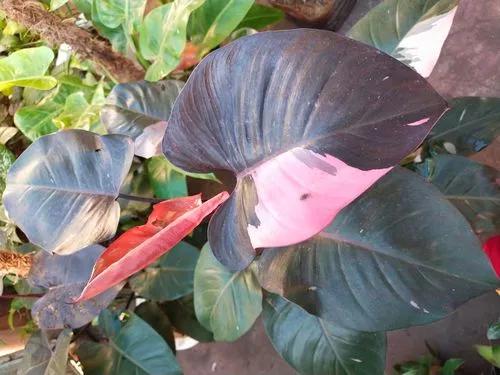If foliage color and pattern are your cup of tea, Caladium bicolor suits your taste. Commonly known as Caladium or Angel Wings, this tropical plant has captured the heart of many with its vibrant, multicolored foliage. It’s a favorite among gardeners not only for its unique beauty but also for its ease of care.
The Heart Of Jesus Care
Caladium Bicolor



Caladium bicolor is a perennial plant native to Central and South America, primarily found in the Amazon rainforest. Those heart-shaped leaves that come in striking colors and patterns set this plant apart. They typically grow to 1-2 feet tall and are perfect as ornamental houseplants or as annual outdoor bedding or borders.
The Caladium flowers resemble Calla lily, producing spadix inflorescence. They come in yellow, gold, or green colors and bloom anytime from spring to fall. However, they remain inconspicuous and are often overshadowed by the colorful foliage.
Despite its beauty, Caladium bicolor carries a poisonous characteristic. It contains high amounts of calcium oxalates that can cause mouth swelling, nausea, vomiting, diarrhea, and skin irritation when swallowed. So, it’s best to keep this plant away from pets and kids.
How to Care for the Plant

Water

Water the soil regularly, as Caladiums prefer consistently moist soil. To avoid waterlogging, water the plant only when the top inch of the soil feels dry. Be mindful of overwatering, as it can lead to root rot.

Pruning

It’s not advisable to prune Caladiums extensively. Occasional removal of yellowing, damaged, or diseased leaves can promote healthier growth and improve the plant's overall appearance. Trim close to the base of the stem with clean, sharp scissors or pruning shears.

Fertilizer

If the soil is rich, fertilizer may no longer be necessary. But if potted, you should fertilize your Caladium bicolor every 4-6 weeks during the growing season (spring and summer). Opt for a water-soluble fertilizer low in phosphorus. Be wary of overfertilizing, as this can lead to excessive foliage growth at the expense of vibrant leaf colors.

Sunlight

One good thing about Caladiums is that they can adapt to various light conditions. While they thrive in bright, indirect light, they can also tolerate partial shade. Direct, harsh sunlight can scorch their delicate foliage. Hence, it isn’t advisable.

Soil

A well-draining, rich potting mix is ideal for Caladiums. The soil should be loamy and slightly acidic. It’s best to add organic matter to the soil mix to improve its overall structure and texture.

Propagation

Propagation of Caladium bicolor is through bulb division. When the plant goes dormant in the fall, dig up the bulbs and divide them into smaller sections. Each section should have at least one healthy bud. Replant the divided bulbs in fresh soil and wait for them to sprout new growth in the spring.

Temperature

Caladiums are tropical plants and thrive in warm, humid conditions. They prefer temperatures between 70°F to 85°F (21°C to 29°C). Exposure to temperatures below 50°F (10°C) can lead to dormancy and leaf drop. Caladium bulbs won’t survive winter cold. You’ll need to bring them indoors so they regrow next season. The best areas to grow Caladium bicolor are those under USDA zones 9a to 10b.

Container

Growing Caladium bicolor in a container is a great choice, as you can use it for display indoors and outdoors. Select a pot with good drainage to prevent waterlogging. The container size should be proportional to the size of the plant, not too small or not too large.

Fun fact

One of the fascinating aspects of Caladium bicolor is its ability to adapt to different light conditions, from shade to partial sun. Its versatility makes it an excellent choice for different garden settings.

Additional

All parts of the Сaladium plant are poisonous, both to people and animals. Use caution when you have caladiums around children or pets.

Popularity

19,728 people already have this plant 2,754 people have added this plant to their wishlists

Common pests

Caladiums are susceptible to common pests such as aphids, mealybugs, and spider mites. Regularly inspect your plants for signs of infestation and treat them as needed with insecticidal soap or neem oil solution. Removing infested parts and isolating the plant will also help prevent pest breakout.

Frequent diseases

Overly wet conditions can cause some fungal diseases to Caladiums, including root rot. Ensure good air circulation and avoid overwatering to prevent fungal issues.

Botanist’s tips

Discover more plants with the list below
Related articles






